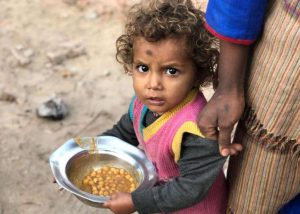OCTOBER 17, 2020

India has climbed eight positions in the Global Hunger Index from the past year and has been ranked 94 among 107 countries in 2020.
In 2019, India was ranked 102 out of 117 countries and in 2018, India had ranked 103 among 119 countries on the Global Hunger Index that is published jointly by Concern Worldwide and Welthungerhilfe.
With a score of 27.2 out of 50, the 2020 Global Hunger Index report terms the level of hunger in India as “serious”.
A score of less than 9.9 signifies “low” hunger, that of 10-19.9 represents “moderate” levels of hunger, 20-34.9 points to “serious” hunger, 35-39.9 signifies “alarming” and over 50 “extremely alarming” levels of hunger.

A score of less than 9.9 signifies “low” hunger, that of 10-19.9 represents “moderate” levels of hunger, 20-34.9 points to “serious” hunger, 35-39.9 signifies “alarming” and over 50 “extremely alarming” levels of hunger.
South Asia has largest number of undernourished people in the world
The report stated that South Asia has the largest number of undernourished people in the world. While this rate is lower than that for Africa South of the Sahara, South Asia has the highest number of undernourished people in absolute terms, with 255 million people undernourished in the region. In recent decades, the prevalence of undernourishment in South Asia has declined, down from 20 percent in 2004–2006 (FAO et al. 2020).

South Asia’s child wasting rate is the highest of any world region. In 2019 the child wasting rate for South Asia was 14.8 percent, compared with 6.9 percent in Africa South of the Sahara (UNICEF, WHO, and World Bank 2020b).
According to one study, in five of six South Asian countries a lower maternal body mass index was significantly associated with child wasting. In some countries, inadequate access to sanitation and improved water sources and low family wealth were also associated with child wasting, albeit not systematically so.

Because a reduction in poverty does not necessarily imply that households get adequate access to improved water sources and sanitation, poverty alleviation policies may not be sufficient to reduce child wasting (Harding, Aguayo, and Webb 2018).
The report said that the high child stunting rate in South Asia is driven by multiple factors. South Asia’s child stunting rate as of 2019 was 33.2 percent, down from 51.3 percent in 2000 (UNICEF, WHO, and World Bank 2020b).
The key factors that contribute to stunting in the region are poor infant and young child feeding practices, poor nutrition among women before and during pregnancy, and poor sanitation practices. Data from 1991 through 2014 for Bangladesh, India, Nepal, and Pakistan showed that stunting is concentrated among children from households facing multiple forms of deprivation, including poor dietary diversity, low levels of maternal education, and household poverty.

Despite declines in recent years, child mortality in South Asia is still unacceptably high, with improvements in child nutrition needed. The mortality rate of children under age five in South Asia as of 2018 was 4.1 percent, compared with 9.2 percent in 2000. India—the region’s most populous country—experienced a decline in under-five mortality in this period, driven largely by decreases in deaths from birth asphyxia or trauma, neonatal infections, pneumonia, and diarrhea. However, child mortality caused by prematurity and low birthweight increased, particularly in poorer states and rural areas.
Prevention of prematurity and low birth weight is identified as a key factor with the potential to reduce under-five mortality in India, through actions such as better antenatal care, education, and nutrition as well as reductions in anemia and oral tobacco use. Evidence from Pakistan also illustrates the connection between child mortality and nutrition: children who were stunted or severely wasted when they began treatment for acute malnutrition had lower odds of recovery and survival.
Courtesy/Source: India Times








































































































